Algebra | Term 2 Chapter 3 | 7th Maths - Laws of Exponents | 7th Maths : Term 2 Unit 3 : Algebra
Chapter: 7th Maths : Term 2 Unit 3 : Algebra
Laws of Exponents
Laws of Exponents
Let us learn some rules to multiply and
divide exponential numbers with the same base.
1. Multiplication of Numbers in Exponential form
Let us calculate the value of 23
× 22
23 ×22
=(2×2×2)×(2×2)
=2×2×2×2×2
= 25
=
23+2
We observe that the base of 23
and 22 is the same 2 and the sum of the powers is 5. Now, let us consider
negative integers as the base.
(−3)3 ×
(−3)2
=
[(−3)
×
(−3)
×
(−3)] × [(−3) × (−3)]
=(−3)
×
(−3)
×
(−3)
×
(−3)
×
(−3)
=(−3)5
=(−3)3+2
We observe that the base of (−3)3
and (−3)2
is the same as (−3) and the sum of the power is 5. Similarly,
p 4 × p2 =
( p × p × p ×
p) × ( p × p) =
p6 = p4 +2
Now, for any non-zero integer ‘a’ and whole number ‘m’ and ‘n’, consider am and an . That is, am = a × a × a × ... × a (m times) and an = a × a × a × ... × a (n times)
So, a m ×
an = a ×
a × a × ... × a (m times) × a
×
a × a × ... × a (n times)
=a ×
a ×
a ×
... ×
a (m+n times) =am
+n
Therefore, a m
× an = am +n
This is called Product Rule of exponents.

Try these
Simplify and write the following in exponential form.
1. 23 ×25
2. p 2 × p4
3. x 6 × x4
4. 31×35 ×34
5. (−1)2 × (−1)3 × (−1)5
Example 3.7
Simplify using Product Rule
of exponents.
(i) 57 ×
53
(ii) 33 ×
32 × 34
(iii) 25 ×
32 ×
625 ×
64
Solution
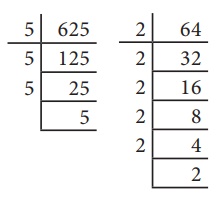
(i) 57 ×
53 = 57+3
[since, a m
× an = am +n ]
= 510
(ii) 33 ×32
×34
=33+2 ×34 =35
× 34
= 35+4 = 39
iii) 25×32×625×64
=(5×5)×(2×2×2×2×2)
× (5×5×5×5)×(2×2×2×2×2×2)
=52 ×25
×54
×26
= (52 × 54) × (25 × 26)
[grouping exponential numbers with the same base]
=
52+4 ×
25+6 = 56 ×
211
2. Division of Numbers in Exponential form
Let us calculate the value of 25 ÷ 22
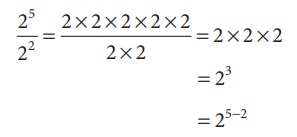
Note
Can you find the value
of a 2 × a0 ?
By Product Rule,
a 2 × a0 = a2 +0
a 2 × a0 = a2
a0 = a2 / a2 = 1
[dividing by a2
on both sides]
Therefore, a0
= 1 , a ≠ 0 .
We observe that the base of 25
and 22 is the same ‘2’ and the difference of powers is 3. Now, let us
consider negative integers as the base.
Consider (−5)3
÷
(−5)2

(−5)3 / (−5)2
=
[(−5)
×
(−5)
×
(−5)]
/ [(−5)
×
(−5)]
= (−5)1 = (−5)3−2
We observe that the base of (–5)3
and (–5)2 is the same as (–5) and the difference of the power is 1.
Thus, we can observe that for any non-zero
integer ‘a’ and for whole numbers ‘m’ and ‘n’, consider am
and an , m > n .
That is, am = a × a × a × ... × a (m times); an = a × a × a × ... × a (n times)
am
/ an = [ a × a × a... × a (m times)
] / [ a × a × a... × a (n times) ] = a × a × a... × a (m − n times
) = am −n
Therefore, am / an
= am −n
This is called Quotient Rule of exponents.
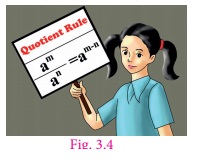
Example 3.8
Simplify using quotient rule
of exponents.

Solution
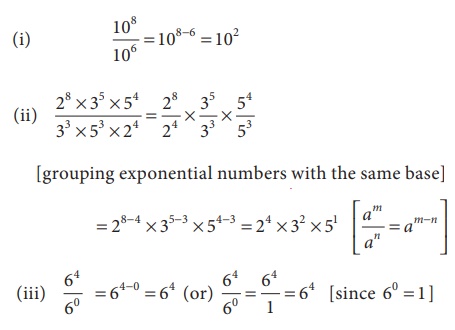
Think
What is Half of 210
? Ragu claims the answer is 25 . Is he correct ? Discuss.
Try these
Simply the following.
1. 235 ÷ 232
2. 116 ÷ 113
3. (−5)3 ÷ (−5)2
4. 73 ÷73
5. 154 ÷ 15
3. Power of Exponential form
Let us find the value of (22)5
(
22)5 = 22 ×
22 × 22 × 22 ×
22 = 22 + 2 +
2 + 2 +2 (By Product rule)
210 =
22×5
Similarly, (33)4 =33 ×33
×33
×33
=
33+3+3+3
=
312 = 33×4
(56
)2 = 56 ×
56 = 56+6 = 512 =
56×2
In general, for any non-zero integer
‘a’ and whole number ‘m’ and ‘n’,
(
am )n = (a m ×
a m × am ... ×
am ) (n
times)
= am + m +m...+m (n
times)
= am ×n
Hence, ( a m )n = am ×n
This is called Power Rule of exponents.
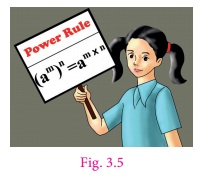
Try these
Simplify and write the following in exponent form.
1. (32)3
2. [(−5)3]2
3. (206)2
4. (103)5
Example 3.9
Simplify using power rule
of exponents.
(i) ( 83 )4
(ii) (115 )2
(iii) ( 26 )2 × ( 24 )7
Solution
(i) (83)4 = 83×4 = 812 [since ( a m )n = am×n ]
(ii) (115
)2 = 115×2 = 1110
[since ( a m )n = am ×n ]
(iii) (26
)2 × (24)7 = 26×2 × 24×7
[since ( a m )n = am ×n ]
= 212 × 228
=
212 +228 = 240
[since (am × an = am+n ]
Think
We learnt that 22
= 2 × 2 .
What is the value of 222
? Discuss.
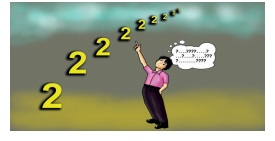
4. Exponent Numbers with Different Base and Same Power
1. To understand
the multiplication of exponent numbers with different base and same powers, let
us consider the following example,
105 =
10 ×10 ×10 ×10 ×10
= (2×5)×(2×5)×(2×5)×(2×5)×(2×5)
= (2×2×2×2×2)×(5×5×5×5×5)
105 =25
×55
But we know that, 10 = 2 × 5. Hence 105
= (2 × 5)5 = 25 × 55 .
In general, for any non-zero integers
‘a’ and ‘b’ and for whole number ‘m’ (
m > 0),
a m × bm = a × a × a × ... × a (m
times) × b × b ×
b ×
... ×
b (m times)
= (a × b) × (a × b) × (a × b) × ... × (a × b) (m times) = (a × b)m
Therefore, a m
× bm
= (a × b)m .
2. To understand the division of exponent
numbers with different base and same powers, let us consider the follwing example,
105 =
10 ×10 ×10 ×10 × 10
= (20/2) × (20/2) ×(20/2) ×(20/2) ×(20/2)
= [20×20×20×20×20] / [2×2×2×2×2]
Therefore, 105 = 205 / 25 . But we know that,
10 = (20/2).
Hence, 105 = (20/2)5 = 205 / 25.
Hence, for any two non-zero integers
‘a’ and ‘b’ and a whole number ‘m’ (
m > 0),
(a/b)m = (a/b)
× (a/b) × (a/b) × . . . (a/b) (m times)

= [ a × a × a × ... × a (m times)] / [ b × b × b × ... × b (m
times) ] = am / bm
Therefore, .
(a/b)m = am
/ bm

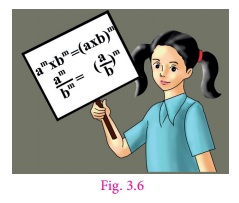
Try these
1. Express the following exponent
numbers using am × bm = (a × b)m
.
(i) 52 ×32
(ii) x 3 × y3
(iii) 74 ×84
2. Simplify the following exponent numbers by using (a/b)m
= am / bm
(i) 53 ÷23
(ii) (−2)4 ÷ 34
(iii) 86 ÷56
(iv) 63 ÷ (−7)3
Example 3.10
Simplify by using the law
of exponents.
(i) 76 ×
36
(ii) 43 ×
23 × 53
(iii) 725 ÷
95
(iv) 613 ×
4813 ÷ 1213
Solution
(i) 76 ×36
= (7×3)6
=216
[Since,
am × bm = (a × b)m ]
(ii) 43 ×23
×53
=(4×2×5)3
=
403 [Rule
extended for 3 numbers]
(iii) 725 ÷ 95
= (72÷9)5 = 85 [Since, am
/ bm = (a / b)m ]
(iv) 613 ×
4813 ÷ 1213 =
613 × (4813 ÷
1213 ) [BIDMAS]
= 613 ×
(48/12)13 [Since, a m
/ bm = (a / b)m ]
= 613 ×
413
= (6 × 4)13 [Since,
a m × bm = (a × b)m
]
= (24)13
1. All the 10 digits appear
once in the expansion of 320432. That is, the value of 320432
= 1026753849 .
2. There are beautiful
equations with same exponent consecutive natural numbers as the base.
32+42 =52
102 + 112 + 122 = 132 + 142
Activity
Finding the pair
Divide the classroom into
two groups. Each group will have a set of cards. Each member of Group 1 has to pair
with one suitable member of Group 2 by stating the reason.
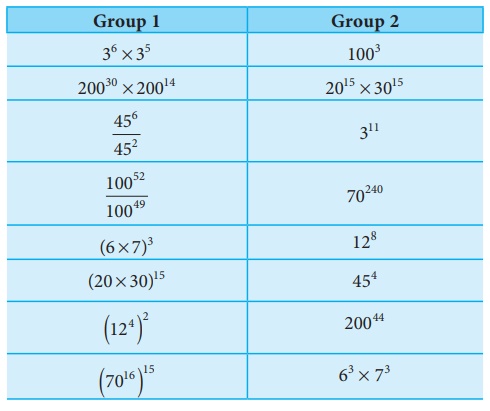
This activity can be extended till all the children in the class are familiarise with the laws of exponents.
Related Topics